Electric Vehicles Empowering the Construction of Green Sustainable Transportation Networks in Chinese Cities: Dynamic Evolution, Frontier Trends, and Construction Pathways
Abstract
1. Introduction
2. Materials and Methods
2.1. Data Sources and Retrieval Strategies
2.2. Research Methods and Tools
3. Publication Trend, Country Cooperation, and Geographical Distribution
3.1. The Number and Trend of Publications
3.2. Dual-Map Overlay Analysis of Disciplinary Citation Paths
3.3. Co-Citation Analysis of References and Journals
3.4. Country Cooperation and Geographical Distribution
4. Analysis of Author Cooperation and Institution Cooperation
4.1. Author Cooperation View Analysis
4.2. Institution Cooperation View Analysis
5. Keywords Analysis
5.1. Keyword Co-Occurrence Analysis
5.2. Keyword Timezone Analysis
- (1)
- Keyword time zone analysis of the CNKI literature.
- (2)
- Keyword time zone analysis of the WOS literature.
5.3. Keyword Cluster Analysis
- (1)
- Research on the infrastructure of electric vehicles.
- (2)
- Research on electric vehicles to aid in energy conservation and emission reduction, low carbon output, and environmental protection.
- (3)
- Research on electric vehicles and their contributions to the green, low carbon, and sustainable development of urban transportation.
6. Analysis of the Evolution Trend in Timeline Form
7. Discussion
7.1. Publication Trends and Country Cooperation in the Literature
7.2. Author Cooperation and Institutional Cooperation
7.3. The Evolution of Keyword Research via Timeline
- (1)
- 1993–2008: initial exploration stage.
- (2)
- 2009–2020: rapid development period.
- (3)
- 2021–2024: high-speed development and “twin goals”.
7.4. Research Hot Spots and Frontier Trends
7.5. The Impact Analysis of Electric Vehicles on the Urban Transportation Network in China
- (1)
- Policy Dimension: The Contradiction between Policy Incentives and Implementation Gaps.
- (2)
- Technological Dimension: The Disconnect Between Technological Advancement and Practical Application.
- (3)
- Infrastructure Dimension: The Contradiction of Challenges in the Construction and Popularization of Charging Networks.
- (4)
- Social Dimension: Challenges of Enhanced Awareness of Green Travel and the Lag in Usage Habits.
- (5)
- Economic Dimension: Dual Challenges of Market Competitiveness and Industry Chain Improvement.
- (6)
- Environmental Dimension: The Dual Challenge of Insufficient Life Cycle Assessment and the Lack of Ecological Benefit Monitoring.
8. The Path of Electric Vehicles to Build an Urban Green Transportation Network
8.1. Exploring China’s Solutions for Building a Green Transportation Network
8.1.1. Policy Support
8.1.2. Technological Innovation
8.1.3. Infrastructure Construction
8.1.4. Social Acceptance
8.1.5. Economic Benefits
8.1.6. Environmental Protection
8.2. Analysis of Implementation Difficulty and Potential Impact in Cities of Different Sizes
8.3. Differentiated Implementation Pathways for Green Transportation Networks
- (1)
- Implementation path for large cities.
- (2)
- Implementation path for medium-sized cities.
- (3)
- Implementation Path for Small Cities.
9. Conclusions, Research Limitations, and Research Prospects
9.1. Conclusions
9.2. Research Limitations
9.3. Prospects for Future Research
- (1)
- Research on vehicle intelligence.
- (2)
- Research on lightweight materials for vehicles.
- (3)
- Research on autonomous driving technology.
- (4)
- Research on power battery technology innovation.
- (5)
- Research on urban transportation planning.
Author Contributions
Funding
Data Availability Statement
Conflicts of Interest
References
- Li, K.; Tian, X.; Zheng, S.; Jiang, S. Research on new energy vehicle infrastructure construction in heze under the background of “double carbon”. Automob. Appl. Technol. 2023, 48, 14–18. [Google Scholar] [CrossRef]
- Ma, L. The digital and intelligent transformation of the “dual carbon” industry: Mechanisms, challenges and responses: From the perspective of three elements of digitization and intelligence. Ecol. Econ. 2024, 40, 5–54. [Google Scholar]
- Qu, R.; Ye, J.; Zhang, X. Hot spots and trends in green and low-carbon building retrofit research in the context of urban renewal. Green Build. 2024, 6, 69–77. [Google Scholar]
- Liu, S.; Li, W.; Liu, D. Green Travel is the Necessary Path for the Green and Low-Carbon Transformation of Urban Transportation. China Communications News, 11 August 2023. Available online: https://www.zgjtb.com/2023-08/11/content_369962.html (accessed on 11 August 2023).
- Bradshaw, C. The Valuing of Trips. In The Walk n Roll City, Second Car-Free Cities Conference, Toronto, January 1992; Revised Sep 1994; Prepared for Ottwalk and the Transportation Working Committee of the Ottawa–Carleton Round-Table on the Environment; Transportation & Infrastructure Committee: Toronto, ON, Canada, 1994. [Google Scholar]
- Yang, T.; Peng, J.; Yu, M.; Ying, F. Green Transportation Planning in New Town of China: Take Naning South New Town as Example. Urban Transp. China 2021, 19, 58–64. [Google Scholar] [CrossRef]
- Lu, H. Approaches Towards Realization of Urban GreenTransportation. Urban Transp. China 2009, 7, 23–27. [Google Scholar] [CrossRef]
- Ma, Z.; Gao, Y.; Hu, D.; Wang, J.; Ma, F.; Xiong, Y. Green transportation level measurements and spatial-temporal evolution characteristics of urban agglomeration transportation systems. J. Tsinghua Univ. (Sci. Technol.) 2022, 62, 1236–1250. [Google Scholar] [CrossRef]
- Wang, Y.; Tian, Z.; Xue, B.; Li, H.; Ma, T. Review on Optimization Methods of Green TransportationSystem in Urban Built Environment. Shanghai Urban Plan. Rev. 2023, 6, 11–17. [Google Scholar]
- Yu, H.; Yang, Q. Evaluation of the Development Level of Green Transportation in National Central Cities. Sustainability 2024, 16, 7270. [Google Scholar] [CrossRef]
- Gao, X.; Ding, C.; Hou, X.; Duan, D. Green transportation technology innovation in China city system: Dynamies and determinants. Geogr. Sci. 2025, 45, 119–129. [Google Scholar] [CrossRef]
- Lu, H. Current Situation analysis and countermeasures of green and low carbon transport transformation in China. China Sustain. Trib. 2024, Z2, 53–57. [Google Scholar]
- Wang, J.; Hao, Y.; Zhao, J.; Liu, R.; Wang, S.; Tian, S. Connotation and Development Path of Green Transportation in the Context of Urban Low-Carbon Transformation. Urban Transp. China 2024, 22, 52–57. [Google Scholar] [CrossRef]
- Zhao, Y.; Wang, X. Low-carbon emission reduction potential and impact analysis of electric vehicles. Heilongjiang Environ. J. 2022, 35, 120–121. [Google Scholar]
- Zhou, Q. Research on the development trend of intelligent transportation system and its optimization strategy. People’s Public Transp. 2024, 14, 20–22. [Google Scholar] [CrossRef]
- Wang, Y.; Xu, W.; Hu, Q. Integration and coordination in the development of China’s electric vehicle industry: Mechanisms and policy implications. China Econ. 2024, 19, 2–30. [Google Scholar] [CrossRef]
- The Communist Party of China Central Committee and the State Council, Working Guidance for Carbon Dioxide Peaking and Carbon Neutrality in Full and Faithful Implementation of the New Development Philosophy. Available online: https://www.gov.cn/zhengce/2021-10/24/content_5644613.htm (accessed on 24 October 2021).
- The Central People’s Government of the People’s Republic of China. Action Plan Carbon Dioxide Peaking Before 2030. Available online: https://www.gov.cn/gongbao/content/2021/content_5649731.htm (accessed on 24 October 2021).
- Sun, Y.; Zhuang, H. Research on the Rule of Law Guarantee for Green Transportation under the Carbon Peaking and Carbon Neutrality Goals. J. Kunming Univ. 2023, 45, 69–78. [Google Scholar] [CrossRef]
- Tong, Z.M.; Guan, S.; Zhang, Q.G.; Cao, X.E. Data-driven energy efficient speed planning for battery electric industrial vehicles: Forklift as a case study. J. Clean. Prod. 2024, 443, 140923. [Google Scholar] [CrossRef]
- Lu, P.Y.; Hamori, S.; Sun, L.; Tian, S.R. Does the electric vehicle industry help achieve sustainable development goals?-evidence from China. Front. Environ. Sci. 2024, 11, 1276382. [Google Scholar] [CrossRef]
- Kramer, J.; Petzoldt, T. A matter of behavioral cost: Contextual factors and behavioral interventions interactively influence pro-environmental charging decisions. J. Environ. Psychol. 2022, 84, 101878. [Google Scholar] [CrossRef]
- Sebastián, M.G.; Guede, J.R.; Juárez-Varón, D. Analysis of factors influencing attitude and intention to use electric vehicles for a sustainable future. J. Technol. Transf. 2024, 49, 1347–1368. [Google Scholar] [CrossRef]
- Wicki, M.; Brückmann, G.; Bernauer, T. What do we really know about the acceptance of battery electric vehicles?—Turns out, not much. Transp. Rev. 2023, 43, 62–87. [Google Scholar] [CrossRef]
- Vega-Perkins, J.; Newell, J.P.; Keoleian, G. Mapping electric vehicle impacts: Greenhouse gas emissions, fuel costs, and energy justice in the United States. Environ. Res. Lett. 2023, 18, 014027. [Google Scholar] [CrossRef]
- Ji, Y.B.B.; Dong, J.C.; Fei, X.; Wang, G.; Fei, X. Research on carbon emission measurement of Shanghai expressway under the vision of peaking carbon emissions. Transp. Lett.-Int. J. Transp. Res. 2023, 15, 765–779. [Google Scholar] [CrossRef]
- Pucci, P. Spatial dimensions of electric mobility-Scenarios for efficient and fair diffusion of electric vehicles in the Milan Urban Region. Cities 2021, 110, 103069. [Google Scholar] [CrossRef]
- Singh, D.; Paul, U.K.; Pandey, N. Does electric vehicle adoption (EVA) contribute to clean energy? Bibliometric insights and future research agenda. Clean. Responsible Consum. 2023, 8, 100099. [Google Scholar] [CrossRef]
- Shang, H.R.; Sun, Y.T.; Meng, F.X. Life cycle assessment of atmospheric environmental impact on the large-scale promotion of electric vehicles in China. Resour. Environ. Sustain. 2024, 15, 100148. [Google Scholar] [CrossRef]
- Klos, M.J.; Sierpinski, G. Strategy for the Siting of Electric Vehicle Charging Stations for Parcel Delivery Service Providers. Energies 2023, 16, 2553. [Google Scholar] [CrossRef]
- Cai, Y.C.; Zhang, J.; Wang, C.L. An Analytical Framework for Assessing Equity of Access to Public Electric Vehicle Charging Stations: The Case of Shanghai. Sustainability 2024, 16, 6196. [Google Scholar] [CrossRef]
- Tuffour, J.P.; Ewing, R. Can battery electric vehicles meet sustainable energy demands? Systematically reviewing emissions, grid impacts, and coupling to renewable energy. Energy Res. Soc. Sci. 2024, 114, 103625. [Google Scholar] [CrossRef]
- Zhao, X.; Han, J. How Is Transportation Sector Low-Carbon (TSLC) Research Developing After the Paris Agreement (PA)? A Decade Review. Sustainability 2025, 17, 2261. [Google Scholar] [CrossRef]
- Chen, C. CiteSpace II: Detecting and visualizing emerging trends and transient patterns in scientific literature. J. Am. Soc. Inf. Sci. Technol. 2006, 57, 359–377. [Google Scholar] [CrossRef]
- Chen, C. Science mapping: A systematic review of the literature. J. Data Inf. Sci. 2017, 2, 1–40. [Google Scholar] [CrossRef]
- Van Eck, N.; Waltman, L. Software survey: VOSviewer, a computer program for bibliometric mapping. Scientometrics 2010, 84, 523–538. [Google Scholar] [CrossRef]
- Arruda, H.; Silva, E.R.; Lessa, M.; Proença, D., Jr.; Bartholo, R. VOSviewer and bibliometrix. J. Med. Libr. Assoc. JMLA 2022, 110, 392. [Google Scholar] [CrossRef] [PubMed]
- What Is Data Visualization? Definition, Examples, and Learning Resources. Available online: https://www.tableau.com/learn/articles/data-visualization (accessed on 20 March 2025).
- What Is Tableau. Available online: https://www.tableau.com/why-tableau/what-is-tableau (accessed on 20 March 2025).
- He, Y. How the Complexity of Policy Mix Affects Policy Effectiveness—An Analysis Based on the Promotion of New Energy Vehicles. J. Public Manag. 2024, 21, 41–55. [Google Scholar] [CrossRef]
- Wang, L.; Zheng, Q. Innovation Capability and Network Evolution of China’s New Energy Vehicle Industry from a Policy Chain Perspective. Trop. Geogr. 2025, 45, 361–373. [Google Scholar]
- Ajzen, I. The theory of planned behavior. Organ. Behav. Hum. Decis. Process. 1991, 50, 179–211. [Google Scholar] [CrossRef]
- Biresselioglu, M.; Demirbag Kaplan, M.; Yilmaz, B. Electric mobility in Europe: A comprehensive review of motivators and barriers in decision making processes. Transp. Res. Part A Policy Pract. 2018, 109, 1–13. [Google Scholar] [CrossRef]
- Egbue, O.; Suzanna, L. Barriers to widespread adoption of electric vehicles: An analysis of consumer attitudes and perceptions. Energy Policy 2012, 48, 717–729. [Google Scholar] [CrossRef]
- Fornell, C.; Larcker, D. Evaluating Structural Equation Models with Unobservable Variables and Measurement Error. J. Mark. Res. 1981, 18, 39. [Google Scholar] [CrossRef]
- Graham-Rowe, E.; Gardner, B.; Abraham, C.; Skippon, S.; Dittmar, H.; Hutchins, R.; Stannard, J. Mainstream consumers driving plug-in battery-electric and plug-in hybrid electric cars: A qualitative analysis of responses and evaluations. Transp. Res. Part A Policy Pract. 2012, 46, 140–153. [Google Scholar] [CrossRef]
- Helveston, J.; Liu, Y.; Feit, E.; Fuchs, E.; Klampfl, E.; Michalek, J. Will subsidies drive electric vehicle adoption? Measuring consumer preferences in the U.S. and China. Transp. Res. Part A Policy Pract. 2015, 73, 96–112. [Google Scholar] [CrossRef]
- Krupa, J.S.; Rizzo, D.M.; Eppstein, M.J.; Brad Lanute, D.; Gaalema, D.E.; Lakkaraju, K.; Warrender, C.E. Analysis of a consumer survey on plug-in hybrid electric vehicles. Transp. Res. Part A Policy Pract. 2014, 64, 14–31. [Google Scholar] [CrossRef]
- Rezvani, Z.; Jansson, J.; Bodin, J. Advances in consumer electric vehicle adoption research: A review and research agenda. Transp. Res. Part D Transp. Environ. 2015, 34, 122–136. [Google Scholar] [CrossRef]
- Sierzchula, W.; Bakker, S.; Maat, K.; van Wee, B. The influence of financial incentives and other socio-economic factors on electric vehicle adoption. Energy Policy 2014, 68, 183–194. [Google Scholar] [CrossRef]
- Skippon, S.; Garwood, M. Responses to battery electric vehicles: UK consumer attitudes and attributions of symbolic meaning following direct experience to reduce psychological distance. Transp. Res. Part D Transp. Environ. 2011, 16, 525–531. [Google Scholar] [CrossRef]
- Wang, S.; Wang, J.; Li, J.; Wang, J.; Liang, L. Policy implications for promoting the adoption of electric vehicles: Do consumer’s knowledge, perceived risk and financial incentive policy matter? Transp. Res. Part A Policy Pract. 2018, 117, 58–69. [Google Scholar] [CrossRef]
- Kumar, R.R.; Alok, K. Adoption of electric vehicle: A literature review and prospects for sustainability. J. Clean. Prod. 2020, 253, 119911. [Google Scholar] [CrossRef]
- Chan, C.C. The State of the Art of Electric, Hybrid, and Fuel Cell Vehicles. Proc. IEEE 2007, 95, 704–718. [Google Scholar] [CrossRef]
- Clement-Nyns, K.; Haesen, E.; Driesen, J. The Impact of Charging Plug-In Hybrid Electric Vehicles on a Residential Distribution Grid. IEEE Trans. Power Syst. 2010, 25, 371–380. [Google Scholar] [CrossRef]
- Geels, F.W. A socio-technical analysis of low-carbon transitions: Introducing the multi-level perspective into transport studies. J. Transp. Geogr. 2012, 24, 471–482. [Google Scholar] [CrossRef]
- Guo, S.; Zhao, H. Optimal site selection of electric vehicle charging station by using fuzzy TOPSIS based on sustainability perspective. Appl. Energy 2015, 158, 390–402. [Google Scholar] [CrossRef]
- Lund, H.; Kempton, W. Integration of renewable energy into the transport and electricity sectors through V2G. Energy Policy 2008, 36, 3578–3587. [Google Scholar] [CrossRef]
- Nykvist, B.; Nilsson, M. Rapidly falling costs of battery packs for electric vehicles. Nat. Clim. Change 2015, 5, 329–332. [Google Scholar] [CrossRef]
- Offer, G.J.; Howey, D.; Contestabile, M.; Clague, R.; Brandon, N.P. Comparative analysis of battery electric, hydrogen fuel cell and hybrid vehicles in a future sustainable road transport system. Energy Policy 2010, 38, 24–29. [Google Scholar] [CrossRef]
- Sovacool, B.K.; Hirsh, R.F. Beyond batteries: An examination of the benefits and barriers to plug-in hybrid electric vehicles (PHEVs) and a vehicle-to-grid (V2G) transition. Energy Policy 2009, 37, 1095–1103. [Google Scholar] [CrossRef]
- Yong, J.Y.; Ramachandaramurthy, V.K.; Tan, K.M.; Mithulananthan, N. A review on the state-of-the-art technologies of electric vehicle, its impacts and prospects. Renew. Sustain. Energy Rev. 2015, 49, 365–385. [Google Scholar] [CrossRef]
- Ciez, R.E.; Whitacre, J.F. Examining different recycling processes for lithium-ion batteries. Nat. Sustain. 2019, 2, 148–156. [Google Scholar] [CrossRef]
- Dunn, J.B.; Gaines, L.; Kelly, J.C.; James, C.; Gallagher, K.G. The significance of Li-ion batteries in electric vehicle life-cycle energy and emissions and recycling’s role in its reduction. Energy Environ. Sci. 2015, 8, 158–168. [Google Scholar] [CrossRef]
- Harper, G.; Sommerville, R.; Kendrick, E.; Driscoll, L.; Slater, P.; Stolkin, R.; Anderson, P. Recycling lithium-ion batteries from electric vehicles. Nature 2019, 575, 75–86. [Google Scholar] [CrossRef]
- Hawkins, T.; Gausen, O.; Strømman, A. Environmental impacts of hybrid and electric vehicles—A review. Int. J. Life Cycle Assess. 2012, 17, 997–1014. [Google Scholar] [CrossRef]
- Hawkins, T.; Singh, B.; Majeau-Bettez, G.; Strømman, A. Comparative Environmental Life Cycle Assessment of Conventional and Electric Vehicles. J. Ind. Ecol. 2012, 17, 53–64. [Google Scholar] [CrossRef]
- Nordelöf, A.; Messagie, M.; Tillman, A.; Ljunggren Söderman, M.; Van Mierlo, J. Environmental impacts of hybrid, plug-in hybrid, and battery electric vehicles—What can we learn from life cycle assessment? Int. J. Life Cycle Assess. 2014, 19, 1866–1890. [Google Scholar] [CrossRef]
- Notter, D.A.; Gauch, M.; Widmer, R.; Wäger, P.; Stamp, A.; Zah, R.; Althaus, H. Contribution of Li-Ion Batteries to the Environmental Impact of Electric Vehicles. Environ. Sci. Technol. 2010, 44, 6550–6556. [Google Scholar] [CrossRef]
- Zackrisson, M.; Avellán, L.; Orlenius, J. Life cycle assessment of lithium-ion batteries for plug-in hybrid electric vehicles—Critical issues. J. Clean. Prod. 2010, 18, 1519–1529. [Google Scholar] [CrossRef]
- Chen, L. Policy Support of the Development of New Energy Vehicles Industry. J. Gansu Adm. Inst. 2010, 3, 11–19. [Google Scholar]
- Chen, L. The problems faced by the development of the new energy vehicle industry. Auto Ind. Res. 2011, 6, 2–9. [Google Scholar]
- Chen, L. Inventory of China’s new energy vehicle policies. High-Technol. Commer. 2012, 7, 2–48. [Google Scholar]
- Wang, H.; Shi, H.; Chen, P.; Ou, Y. Analysis on the progress of energy saving and new energy vehicle industrialization in China based on a database. J. Automot. Saf. Energy 2014, 5, 294–297. [Google Scholar]
- Zhang, Y.; Yao, J.; Wang, J.; Chen, L.; Xi, P.; Zhu, M.; Wang, Y.; Fu, W.; Wang, K.; Ge, K.; et al. Key Technologies and Application of Green Building Microgrids for Dual-Carbon Goals. Constr. Sci. Technol. 2023, 11, 114–117. [Google Scholar] [CrossRef]
- Sovacool, B.K.; Kester, J.; Noel, L.; de Rubens, G.Z. The demographics of decarbonizing transport: The influence of gender, education, occupation, age, and household size on electric mobility preferences in the Nordic region. Glob. Environ. Change-Hum. Policy Dimens. 2018, 52, 86–100. [Google Scholar] [CrossRef]
- Chen, C.; de Rubens, G.Z.; Noel, L.; Kester, J.; Sovacool, B.K. Assessing the socio-demographic, technical, economic and behavioral factors of Nordic electric vehicle adoption and the influence of vehicle-to-grid preferences. Renew. Sustain. Energy Rev. 2020, 121, 109692. [Google Scholar] [CrossRef]
- Sovacool, B.K.; Kester, J.; Noel, L.; de Rubens, G.Z. Income, political affiliation, urbanism and geography in stated preferences for electric vehicles (EVs) and vehicle-to-grid (V2G) technologies in Northern Europe. J. Transp. Geogr. 2019, 78, 214–229. [Google Scholar] [CrossRef]
- Lee, D.; Mcdermott, M.H.; Sovacool, B.K.; Isaac, R. Toward just and equitable mobility: Socioeconomic and perceptual barriers for electric vehicles and charging infrastructure in the United States. Energy Clim. Change 2024, 5, 100146. [Google Scholar] [CrossRef]
- Sovacool, B.K. Who are the victims of low-carbon transitions? Towards a political ecology of climate change mitigation. Energy Res. Soc. Sci. 2021, 73, 101916. [Google Scholar] [CrossRef]
- Sovacool, B.K.; Martiskainen, M.; Hook, A.; Baker, L. Decarbonization and its discontents: A critical energy justice perspective on four low-carbon transitions. Clim. Change 2019, 155, 581–619. [Google Scholar] [CrossRef]
- Sovacool, B.K.; Turnheim, B.; Hook, A.; Martiskainen, M. Dispossessed by decarbonisation: Reducing vulnerability, injustice, and inequality in the lived experience of low-carbon pathways. World Dev. 2020, 137, 105116. [Google Scholar] [CrossRef]
- Qiu, D.; Wang, Y.; Ding, Z.; Strbac, G. Graph Reinforcement Learning for Carbon-Aware Electric Vehicles in Power-Transport Networks. IEEE Trans. Smart Grid 2024, 15, 3919–3935. [Google Scholar] [CrossRef]
- Qiu, D.; Wang, Y.; Zhang, N.; Strbac, G.; Kang, C. Decarbonising the GB Power System via Numerous Electric Vehicle Coordination. IEEE Trans. Power Syst. 2024, 39, 5880–5894. [Google Scholar] [CrossRef]
- Tan, Q.; Shan, Z.; Guo, M.; Ding, Y.; Liu, Y. Optimizing supply-demand balance with the vehicle to grid system: A case study. J. Energy Storage 2024, 97, 112900. [Google Scholar] [CrossRef]
- Sun, B.; Zhang, Q.; Mao, H.; Li, Z. Validation of a statistical-dynamic framework for predicting energy consumption: A study on vehicle energy conservation equation. Energy Convers. Manag. 2024, 307, 118330. [Google Scholar] [CrossRef]
- Huo, L.; Qu, J.; Liu, B. International experience and policy recommendations on financial and tax support policies for energy conservation and new energy vehicles. Automob. Parts 2013, 23, 22–25. [Google Scholar]
- Ma, N. Progress and Key Deployment of Research and Development of New Energy Vehicles and Battery Technology in China. Technol. Innov. Appl. 2017, 13, 55. [Google Scholar]
- Xie, Y.; Yu, H.; Zhang, T.; Ou, Y. Interpretation of GB/T 33598-2017: Recycling of Traction Battery Used in Electric Vehicle—Dismantling Specification. Battery Bimon. 2018, 48, 53–55. [Google Scholar] [CrossRef]
- Zheng, J. Liu Yu: Car companies should become pioneers in energy conservation and emission reduction. Automot. Obs. 2021, 6, 30–31. [Google Scholar]
- Li, L. Shen Ya Nan: Consumer Willingness to Purchase is Key. Automot. Obs. 2021, 6, 36–37. [Google Scholar]
- Chen, X. The “dual carbon” Path of the Automotive Industry. Automot. Obs. 2021, 10, 55–57. [Google Scholar]
- Miao, Y.; Liu, L.; Zhang, Y.; Tan, Q.; Li, J. An overview of global power lithium-ion batteries and associated critical metal recycling. J. Hazard. Mater. 2022, 425, 127900. [Google Scholar] [CrossRef]
- Chen, Q.; Lai, X.; Gu, H.; Tang, X.; Gao, F.; Han, X.; Zheng, Y. Investigating carbon footprint and carbon reduction potential using a cradle-to-cradle LCA approach on lithium-ion batteries for electric vehicles in China. J. Clean. Prod. 2022, 369, 133342. [Google Scholar] [CrossRef]
- Feng, X.; Zhang, F.; Feng, J.; Jin, C.; Wang, H.; Xu, C.; Ouyang, M. Propagation dynamics of the thermal runaway front in large-scale lithium-ion batteries: Theoretical and experiment validation. Int. J. Heat Mass Transf. 2024, 225, 125393. [Google Scholar] [CrossRef]
- Wang, J.; Jia, K.; Ma, J.; Liang, Z.; Zhuang, Z.; Zhao, Y.; Li, B.; Zhou, G.; Cheng, H. Sustainable upcycling of spent LiCoO2 to an ultra-stable battery cathode at high voltage. Nat. Sustain. 2023, 6, 797–805. [Google Scholar] [CrossRef]
- Ren, Z.; Li, H.; Yan, W.; Lv, W.; Zhang, G.; Lv, L.; Sun, L.; Sun, Z.; Gao, W. Comprehensive evaluation on production and recycling of lithium-ion batteries: A critical review. Renew. Sustain. Energy Rev. 2023, 185, 113585. [Google Scholar] [CrossRef]
- Nie, S.; Cai, G.; Huang, Y.; He, J. Deciphering stakeholder strategies in electric vehicle battery recycling: Insights from a tripartite evolutionary game and system dynamics. J. Clean. Prod. 2024, 452, 142174. [Google Scholar] [CrossRef]
- Huang, R.; He, H.; Zhao, X.; Gao, M. Longevity-aware energy management for fuel cell hybrid electric bus based on a novel proximal policy optimization deep reinforcement learning framework. J. Power Sources 2023, 561, 232717. [Google Scholar] [CrossRef]
- Huang, R.; He, H. Naturalistic data-driven and emission reduction-conscious energy management for hybrid electric vehicle based on improved soft actor-critic algorithm. J. Power Sources 2023, 559, 232648. [Google Scholar] [CrossRef]
- Zou, P.; Zhang, B.; Yi, Y.; Wang, Z. How does travel satisfaction affect preference for shared electric vehicles? An empirical study using large-scale monitoring data and online text mining. Transp. Policy 2024, 146, 59–71. [Google Scholar] [CrossRef]
- Aierken, A. Research on the Energy Saving and Emission ReductionEffect and Development Path of New Energy ElectricVehicles. Auto Time 2022, 14, 125–126. [Google Scholar]
- Guo, Q.; Jin, L.; Feng, Y.; Li, S. Research on the Application of New Energy and Energy-saving Technologies for Automobiles. Auto Time 2024, 16, 116–118. [Google Scholar]
- Wang, Y.; Su, L.; Gu, J.; Hong, L. Multi-scenario low-carbon optimization scheduling study for urban distribution networks considering electric vehicle charging demand. Water Resour. Hydropower Eng. 2024, 55, 32–44. [Google Scholar] [CrossRef]
- Li, Y.; Gao, Z.; Wang, K.; Zhou, L.; Wu, X. Uncertainty unit commitment optimization method based on clean development mechanism. Acta Energiae Solaris Sin. 2023, 44, 368–375. [Google Scholar] [CrossRef]
- Li, X. Research on the Development Issues and Countermeasures of New Energy Vehicles in the Context of a Low-Carbon Economy. Car Test Rep. 2023, 18, 62–64. [Google Scholar]
- Zhou, C.; Wang, Y.; Liu, W.L.; Liu, W.S.; Zhang, Y. Construction and application of regional carbon emission index systm for electric vehicles. Coal Econ. Res. 2024, 44, 105–109. [Google Scholar] [CrossRef]
- Xu, Z.; Zhang, C.; Sun, B.; Liu, S. The electric-thermal coupling simulation and state estimation of lithium-ion battery. J. Energy Storage 2023, 58, 106431. [Google Scholar] [CrossRef]
- Yang, X.; Xie, Z.; Lu, X.; Wei, M.; Tan, X.; Ling, H.; Li, Y. Research on the utilization of ultra-long carbon nanotubes in lithium-ion batteries based on an environment-friendly society. Environ. Sci. Pollut. Res. 2023, 30, 56003–56015. [Google Scholar] [CrossRef] [PubMed]
- Li, J. Economic analysis of retired batteries of electric vehicles applied to grid energy storage. Int. J. Low-Carbon Technol. 2023, 18, 896–901. [Google Scholar] [CrossRef]
- Wang, K.; Hu, T.; Shi, P.; Min, Y.; Wu, J.; Xu, Q. Efficient Recovery of Value Metals from Spent Lithium-Ion Batteries by Combining Deep Eutectic Solvents and Coextraction. ACS Sustain. Chem. Eng. 2022, 10, 1149–1159. [Google Scholar] [CrossRef]
- Xue, B.; Chang, Z.; Wu, H.; Hu, Y.; Huang, K.; Yu, Y. Research on Sustainable Development of Small Vehicle Power Battery for Carbon Neutrality. Adv. New Renew. Energy 2021, 9, 443–448. [Google Scholar] [CrossRef]
- Liu, Z.; Liu, G.; Cheng, L.; Gu, J.; Yuan, H.; Chen, Y.; Wu, Y. Development of sustainable and efficient recycling technology for spent Li-ion batteries: Traditional and transformation go hand in hand. Green Energy Environ. 2024, 9, 802–830. [Google Scholar] [CrossRef]
- He, H.; Wei, J.; Wang, Z. Research on Efficiency and Environmental Protection of Electric Vehicle Charging System. Car Test Rep. 2024, 9, 149–151. [Google Scholar]
- Chen, H.; Luo, X.; Zhang, J. Study on Demand Prediction and Development Planning of Eleetric Vehicle Charging Infrastructure. Electr. Eng. 2024, 12, 33–35. [Google Scholar]
- Fan, L.; Liu, W.; Lu, L. Based on the analysis of Automotive New Energy and Energy Saving Technology Application. Auto Time 2022, 24, 127–129. [Google Scholar]
- Wu, X. Research on Energy Saving of EV Based on Big Data. Automot. Dig. 2022, 12, 1–6. [Google Scholar] [CrossRef]
- Gong, H.; Zhong, H.; Sun, M.; Xie, X. Energy Conservation and Emission Reduction Effect and Development of New-energy Electric Vehicles. Energy Energy Conserv. 2023, 12, 80–84. [Google Scholar] [CrossRef]
- Yu, B.; Lei, X.; Shao, Z.; Jian, L. V2G Carbon Accounting and Revenue Allocation: Balancing EV Contributions in Distribution Systems. Electronics 2024, 13, 1063. [Google Scholar] [CrossRef]
- Sun, X. Low Carbon City on Perspective of Carbon-emissions Reduction. Appl. Energy Technol. 2019, 7, 17–20. [Google Scholar]
- Li, S. Prospect of Application of Pure Electric Bus in Small and Medium-sized Cities Based on Green Transportation Mode. Logist. Sci-Tech 2019, 42, 91–93. [Google Scholar] [CrossRef]
- Xuan, Y.; Fan, L.; Sun, Z.; Jiang, J.; Chen, D.; Deng, K.; Wang, M. An optimal allocation method for electric vehicle charging stations considering low carbon transportation. Zhejiang Electr. Power 2024, 43, 69–79. [Google Scholar] [CrossRef]
- Ding, L. The Current Situation and Development Suggestions for Carbon Emissions Management in the Domestic and Overseas Automotive Industry under the Background of “Peak Carbon Dioxide Emissions and Carbon Neutrality”. Shanghai Auto 2023, 7, 4–9. [Google Scholar] [CrossRef]
- Cheng, G.Y.; Gao, Z.Q. Policy Proposals on Accelerating the Independent Development of China’s Electric Vehicle Industry. Forum Sci. Technol. China 2010, 6, 64–66. [Google Scholar] [CrossRef]
- Pan, H. Research on the Promotion and Application Strategy of Urban New Energy Vehicles Based on Low Carbon Transportation Development: A Case Study of Shenzhen. Auto Ind. Res. 2015, 06, 14–19. [Google Scholar]
- Guo, J.F.; Zhang, X.M.; Chao, Q.; Gu, F. Electric vehicles contribute to China’s energy security and carbon peaking and carbon neutrality. Bull. Chin. Acad. Sci. 2024, 39, 397–407. [Google Scholar] [CrossRef]
- Mo, L.; Liu, B.; Shi, H.; Ma, N. Research on Carbon Emission Assessment of Automotive Products Based on Life Cycle Assessment and Suggestions for Low Carbon Development. Automot. Dig. 2022, 11, 57–62. [Google Scholar] [CrossRef]
- Li, W.; Zou, Y.; Zhu, C. Electric Vehicle Revolution: New Track for Industrial Competition among Major Countries. Int. Econ. Rev. 2023, 4, 93–117. [Google Scholar]
- General Office of the State Council of the People’s Republic of China. New Energy Vehicle Industry Development Plan (2021–2035). Available online: https://www.gov.cn/zhengce/content/2020-11/02/content_5556716.htm (accessed on 2 November 2020).
- National Development and Reform Commission, PRC. Implementation Opinions on Further Enhancing the Service Guarantee Capability of Electric Vehicle Charging Infrastructure. Available online: https://www.gov.cn/zhengce/zhengceku/2022-01/21/content_5669780.htm (accessed on 21 January 2022).
- Guan, X.; Tian, Z.; Si, H.; Ren, Y. Research on the Carbon Emission Reduction Effect and Influencing Factors of New Energy Vehicles in China for Carbon Neutrality. Soft Sci. 2025, 1–18. Available online: https://link.cnki.net/urlid/51.1268.g3.20250310.1757.01081 (accessed on 22 March 2025).
- Chen, C.; Lin, Z.; Huang, C.; Zhao, J.; Ou, S. Review of Decision-Making Analysis for Transportation Energy Transition. J. South China Univ. Technol. (Nat. Sci. Ed.) 2025, 53, 32–48. [Google Scholar]
- Chen, W.; Huang, Z. WTO Compliance of US’s Clean Vehicle Tax Credit: Suggestions on China’s Initiatives to the Reform of the Rules on New Energy Subsidies. Bus. Econ. Law Rev. 2024, 6, 30–46. [Google Scholar]
- Wang, J. Challenges and Strategies for High-Quality Development of China’s Electric Vehicle Industry Under Technological Transformation. Enterp. Econ. 2024, 43, 15–24. [Google Scholar] [CrossRef]
- Hong, J.; Liang, F.; Yang, J.; Li, K. New energy vehicle industry and technology development status. Sci. Technol. Rev. 2023, 41, 49–59. [Google Scholar]
- Zeng, J.; Zhang, J.; Zhang, X. Evolution and trend of the global power battery industry from economic perspective. Battery Bimon. 2024, 54, 855–860. [Google Scholar] [CrossRef]
- Shen, Y.; Yuan, X.; Zhao, S.; Meng, B.; Wang, Y. Energy-saving Optimization Control for Connected Automated Electric Vehicles: State of the Art and Perspective. Acta Autom. Sin. 2023, 49, 2437–2456. [Google Scholar] [CrossRef]
- Zhu, B.; Jia, S.; Zhao, J.; Han, J. Review of Research on Decision-making and Planning forAutomated Vehicles. China, J. Highw. Transp. 2024, 37, 215–240. [Google Scholar] [CrossRef]
- Shi, P.; Shan, Z.; Zhu, H.; Hai, B.; Wang, L.; Lu, F. A Review of Integrated Design Technologies for New Energy Vehicle Power Battery Systems. China Mech. Eng. 2025, 1–19. Available online: http://kns.cnki.net/kcms/detail/42.1294.TH.20250117.1359.019.html (accessed on 23 March 2025).
- Editorial Office of China Journal of Highway and Transport. Review on China’s Automotive Engineering Research Progress: 2023. China J. Highw. Transp. 2023, 36, 1–192. [Google Scholar] [CrossRef]
- Guo, Y.; Qin, W.; Wu, L.; Chen, Y.; Cheng, G. How is the “rapid progress” possible?-An analysis based on the technological catch-up in China’s new energyvehicle industry. Stud. Sci. Sci. 2025, 1–20. [Google Scholar] [CrossRef]
- Liu, Z.; Wei, Y. Research on Key Core Technologies for “Lane Changing and Overtaking” in China’s Automotive Industry Evidence from the Intelligent Connected Vehicle Industry. Sci. Res. Manag. 2025, 1–21. Available online: http://kns.cnki.net/kcms/detail/11.1567.G3.20250108.1339.004.html (accessed on 23 March 2025).
- Cao, D. Technology status and development trend of anode materials for lithium-ion batteries. Pet. Refin. Eng. 2024, 54, 1–7. [Google Scholar] [CrossRef]
- Zhai, X.; Sun, X.; Jiang, T.; Bei, X.; Yang, H. A Review on Production Strategy for All-Solid-State Batteries. Automot. Dig. 2022, 2, 31–35. [Google Scholar] [CrossRef]
- Chen, S.; Weng, S.; Zeng, G.; Wang, M. Summary of Lithium-ion Battery Production Process Specifications and Safety Performance Testing Methods. Guangzhou Chem. Ind. 2024, 52, 4–6. [Google Scholar]
- Zhang, B.; Xie, N.; Wang, Y.; Chen, H.; Cao, D. Research on Battery Swapping Standard System for Electric Commercial Vehicle. China Auto 2025, 35, 86–93. [Google Scholar]
- Xu, G. Standardizing the dimensions and communication interfaces of power batteries to promote the development of the new energy vehicle industry. Auto Maint. Repair 2024, 21, 70–75. [Google Scholar] [CrossRef]
- Hu, M.; Li, D.; Wei, L. Research on pricing and charging infrastructure joint investmentstrategies for new energy electric vehicles. Syst. Eng.-Theory Pract. 2025, 1–24. Available online: http://kns.cnki.net/kcms/detail/11.2267.N.20250214.1745.016.html (accessed on 23 March 2025).
- Xing, W.; Wu, W. The Development Logic, International Competition and Prospects of China’s New Energy Vehicle Industry. J. Xinjiang Norm. Univ. (Ed. Philos. Soc. Sci.) 2025, 46, 123–139. [Google Scholar] [CrossRef]
- Ling, S.; Guo, J.; Li, Y.; Ma, S. How should Charging Infrastructure Subsidies Assess the Situation? Analysis Based on Multi-party Dynamic Game. Chin. J. Manag. Sci. 2024, 32, 290–300. [Google Scholar] [CrossRef]
- Li, D.; Lin, W.; Gao, W.; Shang, C. Optimal electric vehicle charging infrastructure subsidy with consumer range anxiety. Syst. Eng.-Theory Pract. 2025, 1–24. Available online: http://kns.cnki.net/kcms/detail/11.2267.N.20240606.1429.015.html (accessed on 23 March 2025).
- Vinicius, B.; Leonardo, B.; Bruno, H.; Tiago, S.; Jorge, V.; Benedito, D. Life cycle assessment comparison of electric and internal combustion vehicles: A review on the main challenges and opportunities. Renew. Sustain. Energy Rev. 2025, 208, 114988. [Google Scholar] [CrossRef]
- Zhao, X.; Li, X. Empirical evidence of the impact of industrial policies on the charging infrastructure industry and their mechanisms. China Popul. Resour. Environ. 2024, 34, 47–57. [Google Scholar]
- Zhang, H.; Liu, Y.; Tan, X.; Qi, Y.; Yang, L.; Jia, M. Research on the impact of leap-forward development of new energy vehicles onurban traffic congestion. Chin. J. Manag. Sci. 2025, 1–19. [Google Scholar] [CrossRef]
- Shen, M.; Jiang, Z.; Zhou, Q.; Yin, J. EV Charging Station as Emerging Urban Infrastructure: New Servicefeatures and planning insights. City Plan. Rev. 2024, 48, 16–27. [Google Scholar]
- Hu, J.; Yan, H.; Zhang, N.; Huang, B.; Chen, R.; Chen, N.; Wang, D.; Lu, J. Cognitive System and Key Issues of Green and Low-Carbon ProductionMode and Life Style. Electr. Power 2023, 56, 246–254. [Google Scholar]
- Wang, N.; Tian, H.; Guo, J. Literature Review of Dynamic Relocation Problem for Electric Shared Vehicles. J. Tongji Univ. (Nat. Sci.) 2023, 51, 1469–1478. [Google Scholar]
- Xu, X.; Ma, Q.; Wang, W. An Analysis of the Direct Network Effect on New Energy Vehicle Promotion-Based on Multiagent Modeling and Simulation. J. Hunan Univ. (Soc. Sci.) 2024, 38, 41–50. [Google Scholar] [CrossRef]
- Ma, J.; Zhang, Y.; Duan, Z.; Tang, L. Research review on behavior strategies of electricvehicles considering charging demands. J. Traffic Transp. Eng. 2024, 24, 66–79. [Google Scholar] [CrossRef]
- Li, M.; Sun, J.; Fu, Y.; Zhao, B. Sharing electric vehicle scheduling and service pricing optimizationbased on battery swapping. J. Chongqing Univ. Technol. (Nat. Sci.) 2024, 38, 169–180. [Google Scholar]
- Lv, R.; Li, B.; Li, M.; Mo, R.; Fang, S.; Guo, M.; Lu, B.; Fu, C. Heterogeneous Impaet of Public Charging Infrastructure on Electric Vehicle Purchases. J. Technol. Econ. 2023, 42, 143–154. [Google Scholar]
- Zhao, X.; Mao, Y.; Li, X. Energy prices and new energy vehicle consumption: A perspective based on consumer expectations. Soft Sci. 2025, 1–14. Available online: http://kns.cnki.net/kcms/detail/51.1268.G3.20250113.1448.010.html (accessed on 23 March 2025).
- Sun, L.; Feng, Z.; Han, M.; Deng, Q. Cost-optimized Elastic Charging Strategy for Electric Vehicles. J. Chin. Comput. Syst. 2024, 45, 132–138. [Google Scholar] [CrossRef]
- Li, Y.; Ouyang, M.; Zhao, Z. Charging Mechanism, System Configuration and Promotion Pathway of Vehicle to Grid for Electric Vehicles. Proc. CSEE 2024, 44, 6920–6940. [Google Scholar] [CrossRef]
- Wu, T.; Huang, K.; Liu, Z.; Jiang, W. Review on the integrated capacity of transportation and power networks. J. Automot. Saf. Energy 2024, 15, 634–649. [Google Scholar]
- Zhang, L.; Xia, Y.; Zu, L. The optimal number of the charging station and government subsidies considering the electric vehicle’s adoption target. Chin. J. Manag. Sci. 2025, 1–35. [Google Scholar] [CrossRef]
- Zhu, C.; Liu, D.; Teng, X.; Zhang, G.; Yu, D.; Liu, S.; Hu, N. Comparative Analysis and Forecast Research on Comprehensive Economy of New Energy Vehicles. Automot. Eng. 2023, 45, 333–340. [Google Scholar] [CrossRef]
- Zhang, Y.; Tang, X. Development Status, Problems and Countermeasures of China’s New Energy Vehicle Industry under the “Dual Carbon” Goal. China Resour. Compr. Util. 2024, 42, 148–153. [Google Scholar] [CrossRef]
- Lin, J.; Zhang, D.; Liu, Y.; Wang, Z. Robust Optimization of Hierarchical Site Selection Location of Centralized Charging Station Based on Uncertain Demand. J. Chongqing Jiaotong Univ. (Nat. Sci.) 2024, 43, 86–95. [Google Scholar] [CrossRef]
- Yuan, H.; Xu, X.; Yan, Z.; Fang, C.; Liu, J. Review of centralized EV charging and battery swappingfacility planning and optimal scheduling. Power Syst. Prot. Control 2024, 52, 157–174. [Google Scholar] [CrossRef]
- Ding, C.; Zhang, M.; Sun, L. China-Europe New Energy Vehicle Industry Disputes: Status Quo, Causes and Prospects. Chin. J. Eur. Stud. 2024, 42, 36–62. [Google Scholar]
- Liu, J.; Li, Z.; Li, C.; Li, Y. Interaction between electric vehicles and power-transportation coupled networks: Current status, challenges and development trends. J. Electr. Power Sci. Technol. 2024, 39, 12–24. [Google Scholar] [CrossRef]
- Yu, X.; Ji, Z.; Ji, L.; Niu, D.; Xu, X. Analysis on Carbon Emission Reduction Potential of Electric Vehicles in China under Goal of Carbon Neutrality and Carbon Peaking. Smart Power 2024, 52, 25–31. [Google Scholar]
- Zhu, M.; Ji, J.; Jin, S.; Ji, Y.; Bie, Y. A state-of-the-art review on the integrated development technology of electric vehicles and clean energy. J. Automot. Saf. Energy 2024, 15, 1–19. [Google Scholar]
- Chen, Y.; Liu, Q.; Xing, Y.; Zhang, C.; Zhang, S. Life cycle assessment and uncertainty analysis of intelligent electric vehicles: A case study of BYD Han EV. Acta Sci. Circumstantiae 2024, 1–14. Available online: https://link.cnki.net/urlid/11.1843.x.20241218.0925.002 (accessed on 23 March 2025).
- Zhu, J.; Xie, C.; Zhang, D.; Lan, J.; Zhou, J. Review of Electric-Carbon Coupling Market Studies: Status, Challenges, and Sustainability Perspectives. Electr. Power Constr. 2025, 46, 158–173. [Google Scholar]
- Song, X.; Deng, C.; Shen, P.; Qian, Y.; Xie, M. Environmental lmpact and Carbon Footprint Analysis of Pure Electric Vehicles Based on Life Cycle Assessment. Res. Environ. Sci. 2023, 36, 2179–2188. [Google Scholar] [CrossRef]
- Gao, D.; Wang, Y.; Zheng, X.; Yang, Q. Electric vehicle charging status monitoring and safety warning method based on deep learning. Electr. Mach. Control 2023, 27, 122–132. [Google Scholar] [CrossRef]
- Yang, L.; Yu, B.; Feng, Y. Life cycle assessment of electric vehicle carbon emissions: A case study of passenger vehicles in China. China Popul. Resour. Environ. 2023, 33, 113–124. [Google Scholar]
- Wang, S.; Kuai, L.; Zhao, L. lmpact of Incentive Policies on the Promotion of New Energy Vehicles in China. J. Technol. Econ. 2024, 43, 64–74. [Google Scholar] [CrossRef]
- Shchurov, N.I.; Dedov, S.I.; Malozyomov, B.V.; Shtang, A.A.; Martyushev, N.V.; Klyuev, R.V.; Andriashin, S.N. Degradation of Lithium-Ion Batteries in an Electric Transport Complex. Energies 2021, 14, 8072. [Google Scholar] [CrossRef]
- Wang, K.; Xue, Y.; Shahidehpour, M.; Chang, X.; Li, Z.; Zhou, Y. Resilience-Oriented Two-Stage Restoration Considering Coordinated Maintenance and Reconfiguration in Integrated Power Distribution and Heating Systems. IEEE Trans. Sustain. Energy 2025, 16, 124–137. [Google Scholar] [CrossRef]
- Zhao, X.; Li, X.; Zhao, Q. Does the new energy vehicles adoption reduce carbon emissions? A perspectiveof spatial spillover effect. J. Arid Land Resour. Environ. 2024, 38, 1–8. [Google Scholar] [CrossRef]
- 2025 Government Work Reports of Beijing. Available online: http://bj.people.com.cn/n2/2025/0122/c14540-41116991.html (accessed on 23 March 2025).
- 2025 Government Work Reports of Shijiazhuang. Available online: https://www.sjz.gov.cn/columns/a42a569b-80e5-43b6-bd7a-f0d09c01f221/202501/24/e56405fb-183b-409b-a5d6-0de287eb45ad.html (accessed on 23 March 2025).
- 2025 Government Work Reports of Tang County. Available online: https://www.tangxian.gov.cn/content-903-181449.html (accessed on 23 March 2025).
- Yu, J.; Guo, P.; Tu, L.; Xue, Y.; Zhang, H. Development Status and Suggestions for the Coordinated Development of Intelligent Connected Vehicles and Smart City Infrastructure. Chin. Overseas Archit. 2024, 7, 70–74. [Google Scholar] [CrossRef]
- Wang, J. Research on the Design and Manufacture of Hghtweight New Energy Special Vehicles. Agric. Mach. Using Maint. 2023, 08, 33–35. [Google Scholar] [CrossRef]
- Guo, J. The Current Status and Future Development Trends of Autonomous Driving Technology. Spec. Purp. Veh. 2024, 8, 46–48. [Google Scholar] [CrossRef]
- Li, H.; Chen, L. Development of Key Material System for Solid-State Batteries. Strateg. Study CAE 2024, 26, 19–33. [Google Scholar] [CrossRef]
- Zhang, Q. Sustainable Urban Road Design and Green Transportation Development. Theor. Res. Urban Constr. 2024, 22, 22–24. [Google Scholar] [CrossRef]
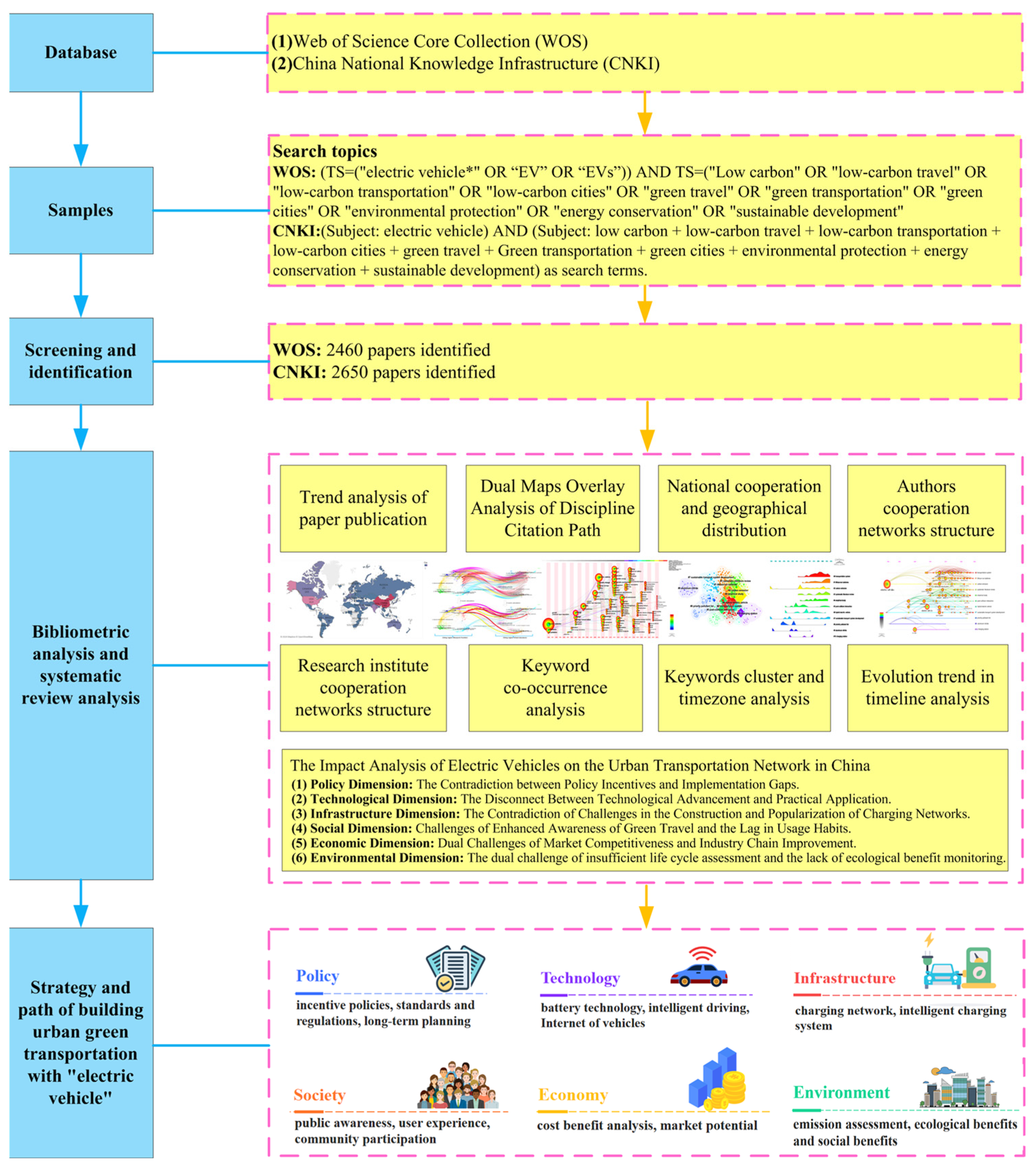

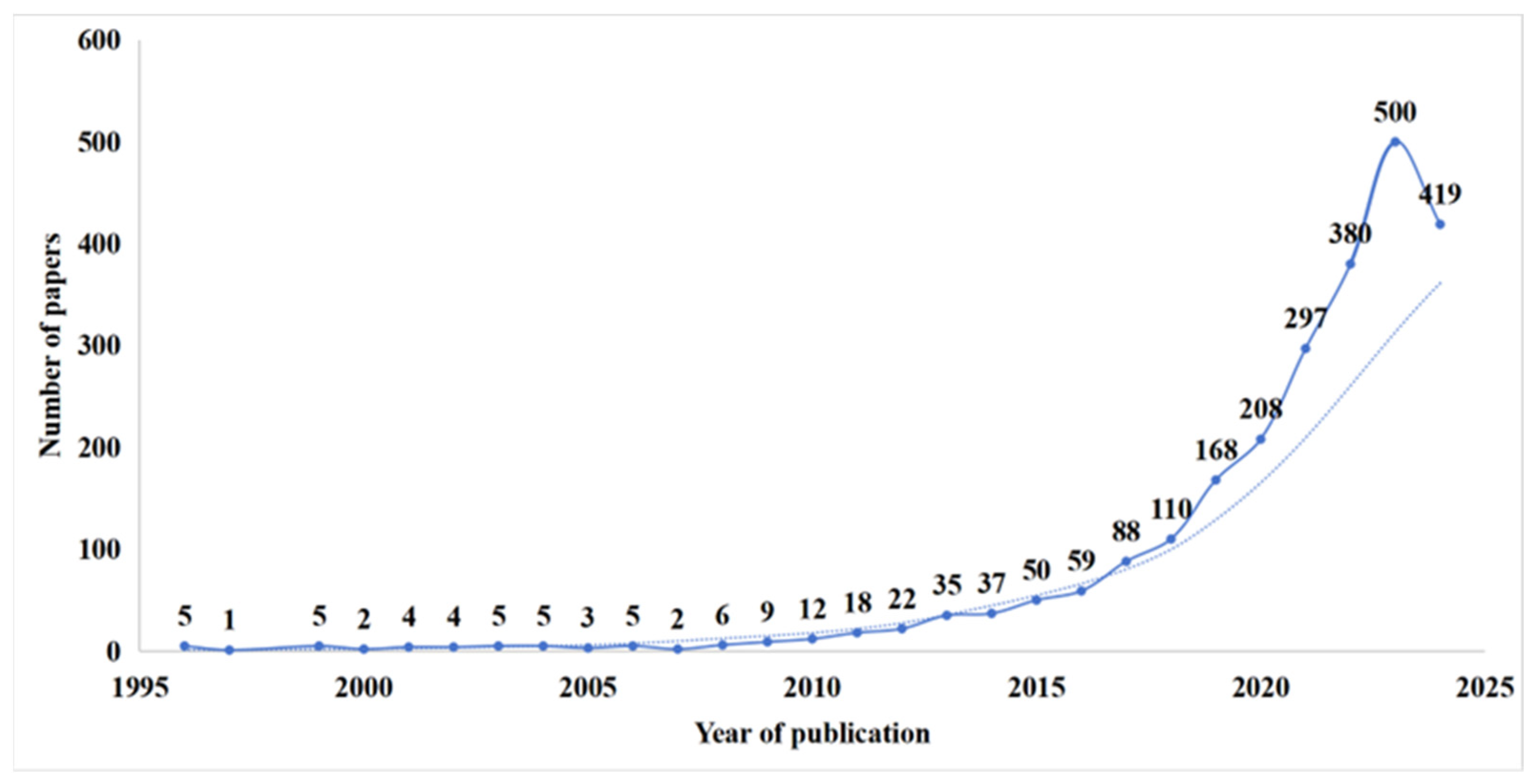
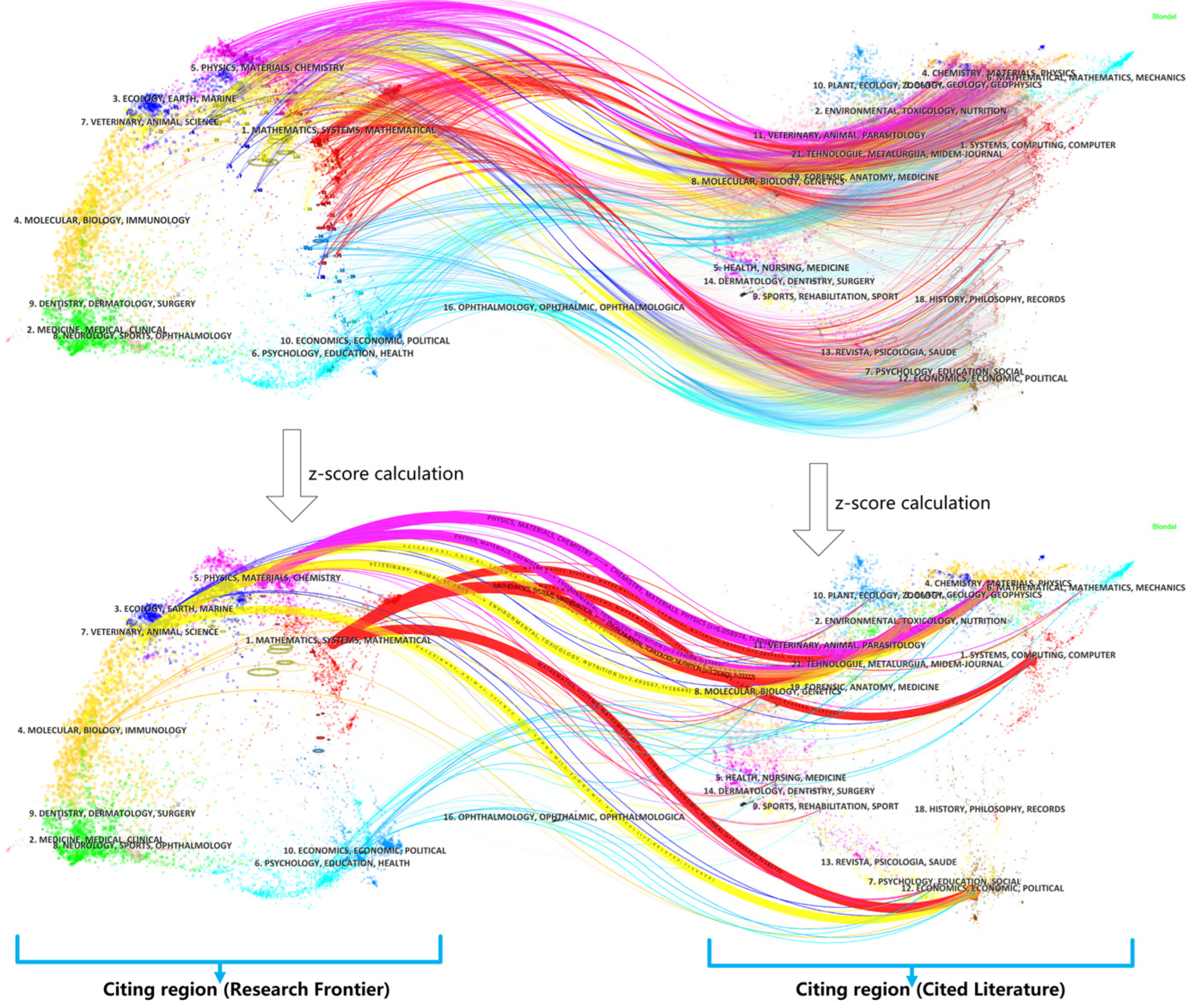



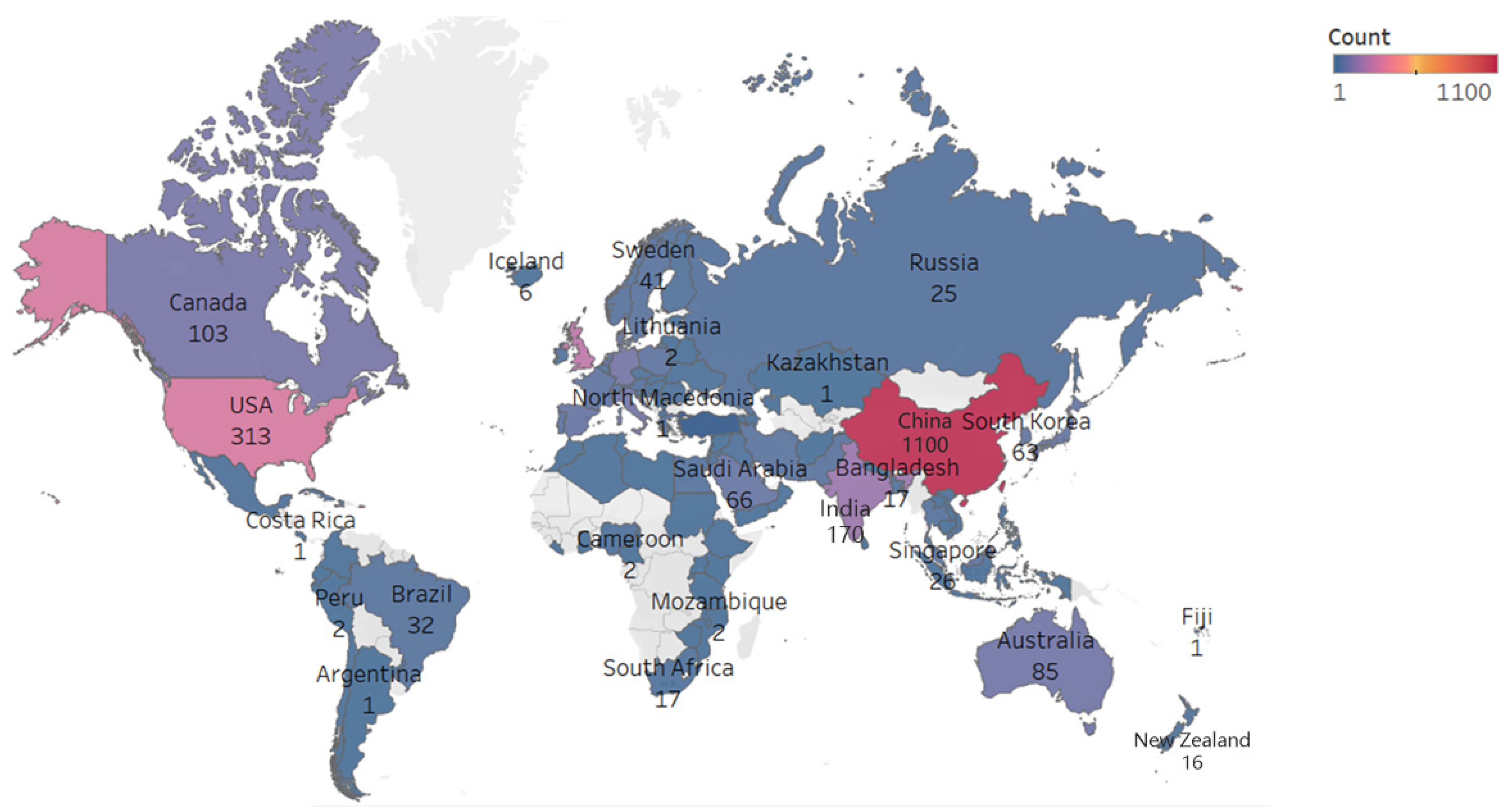
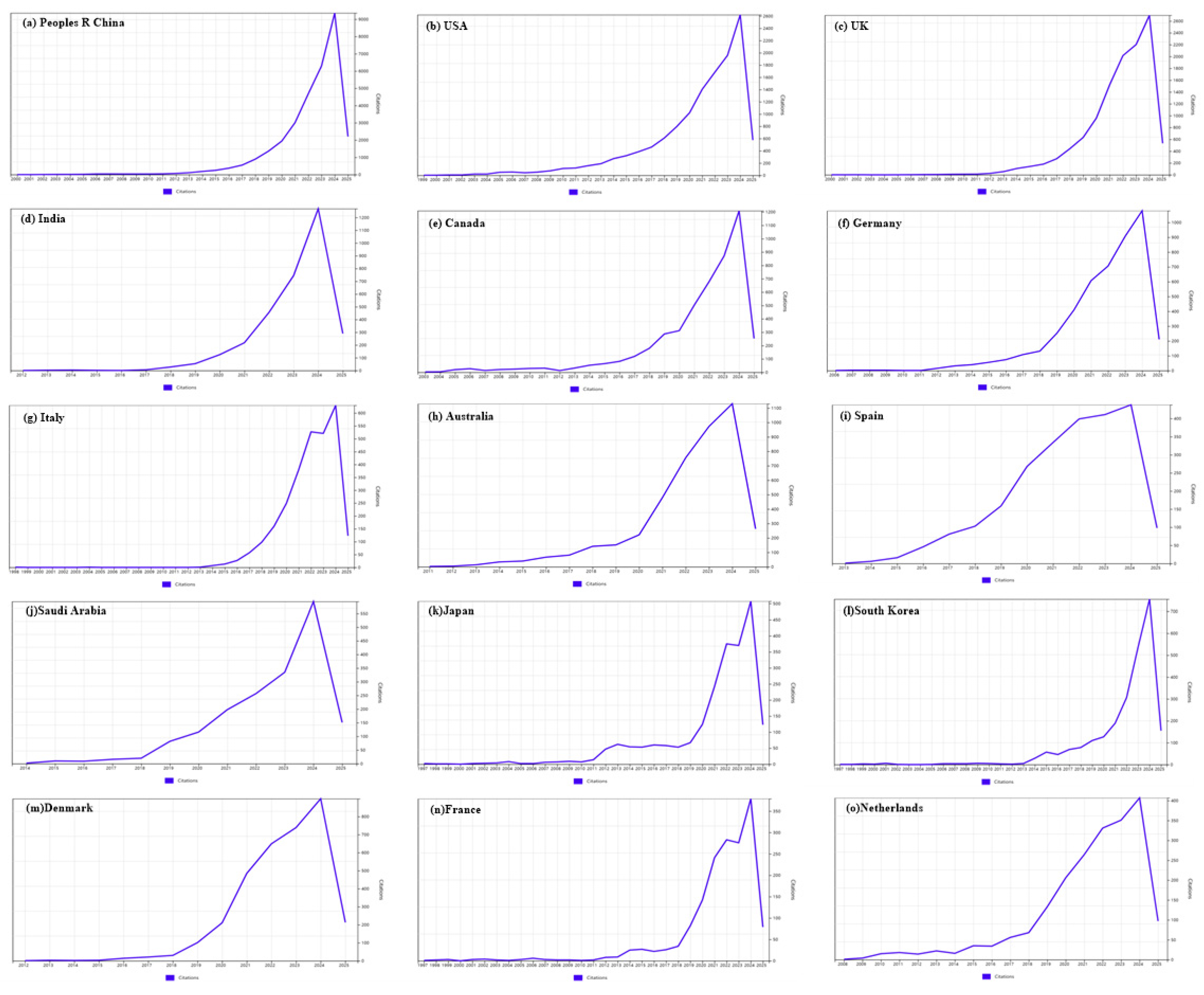


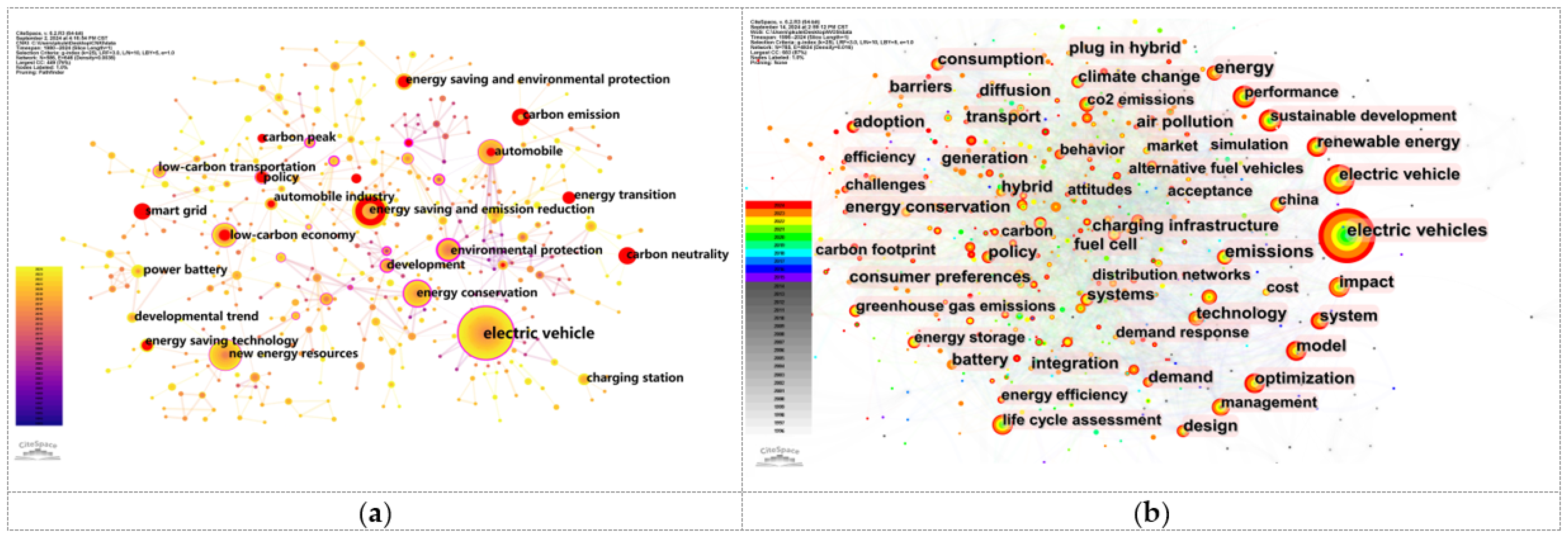
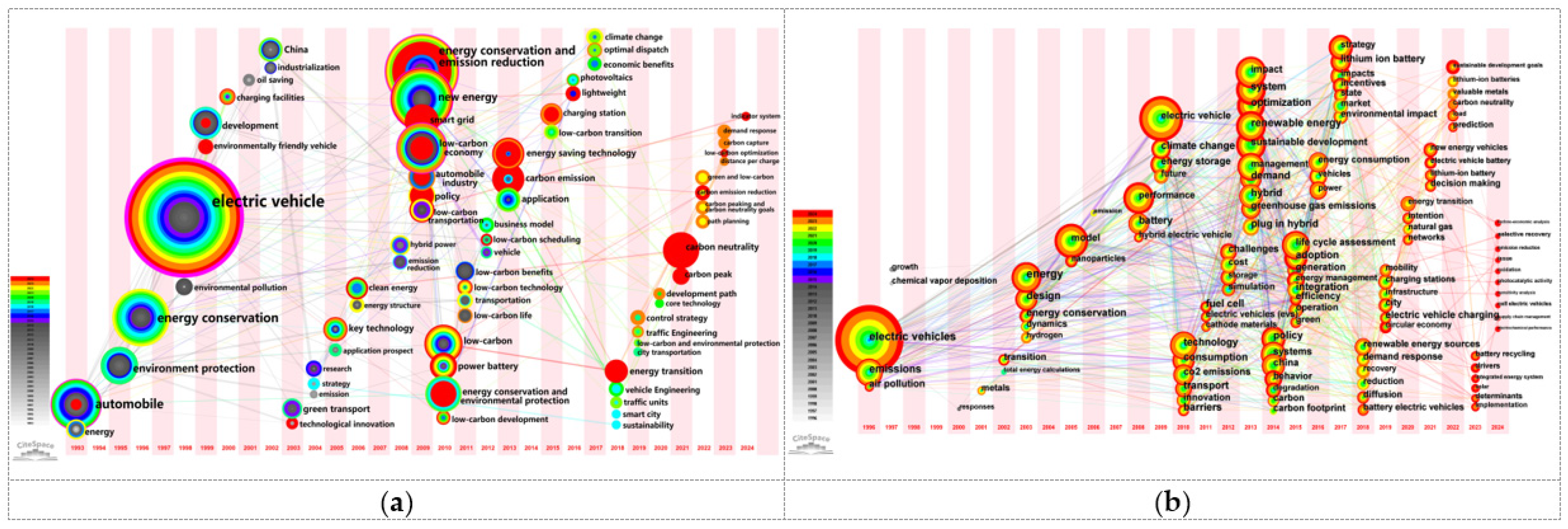


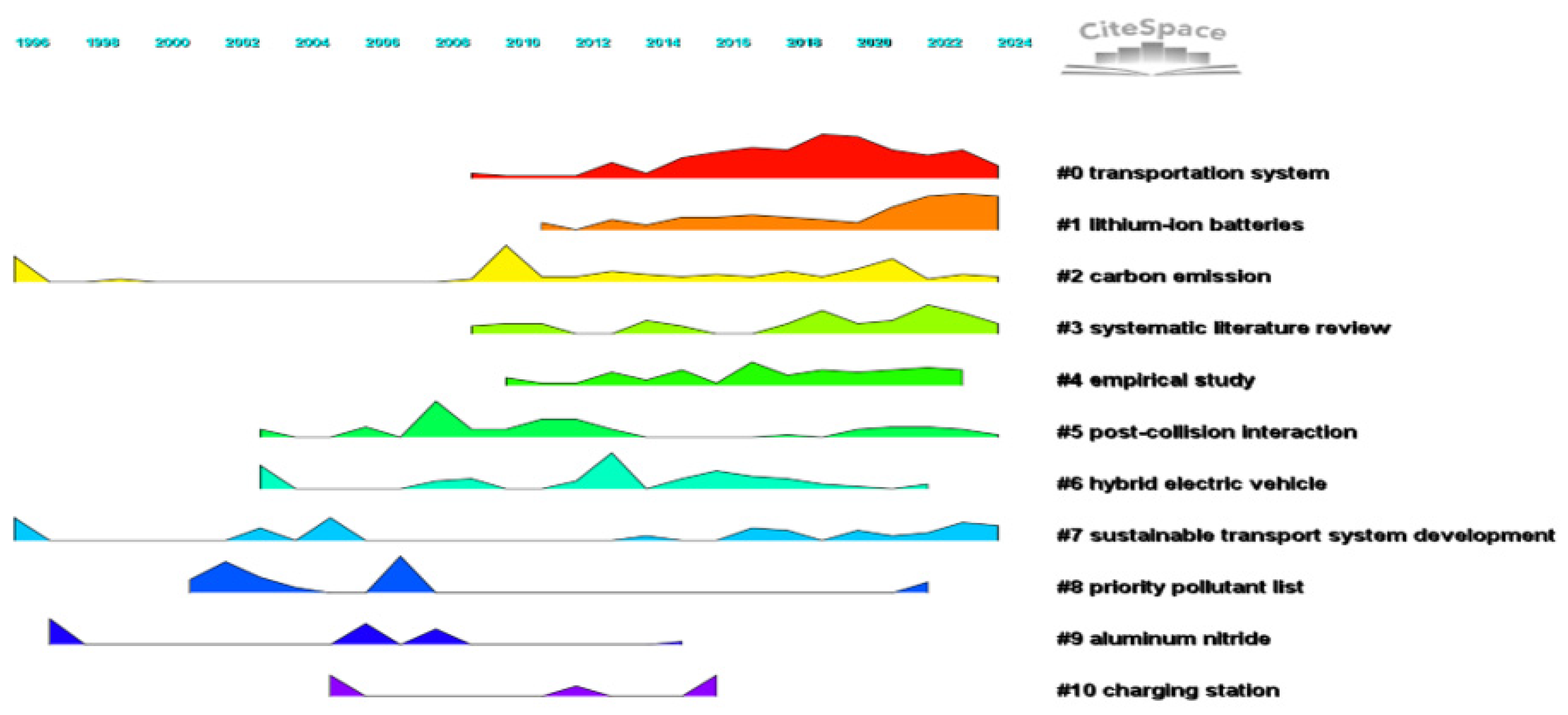
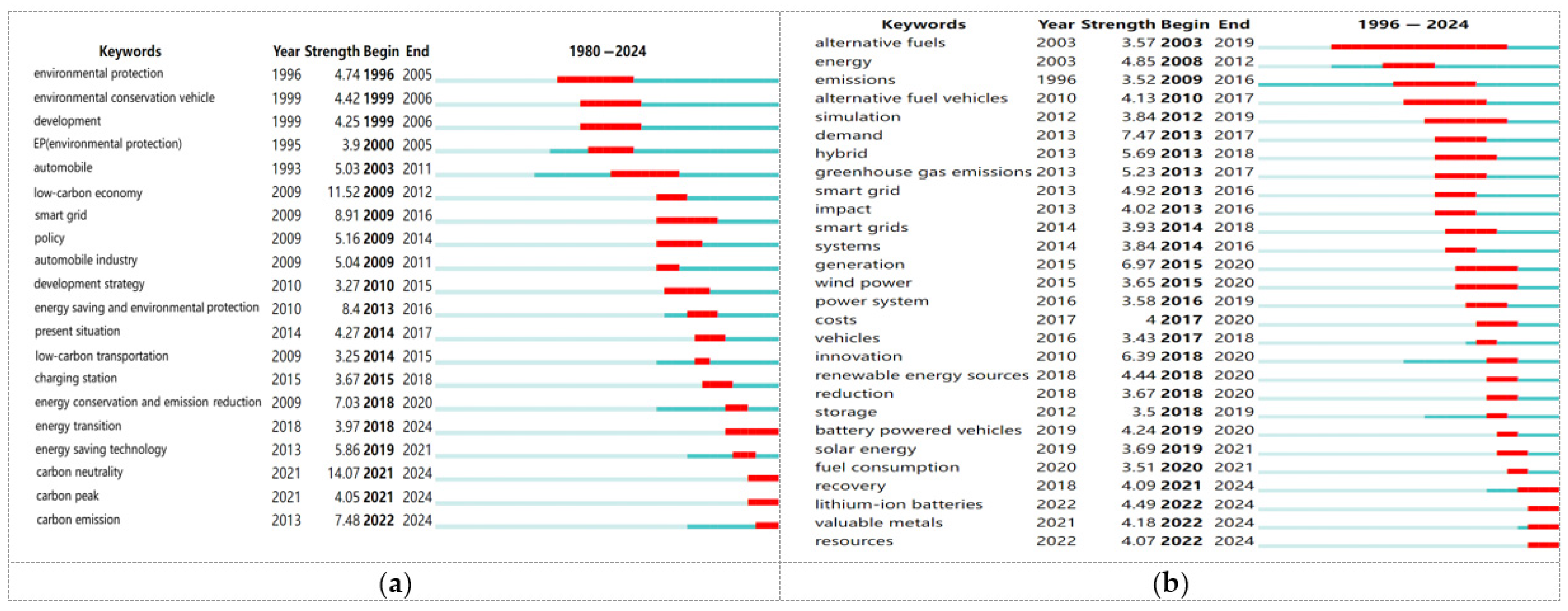
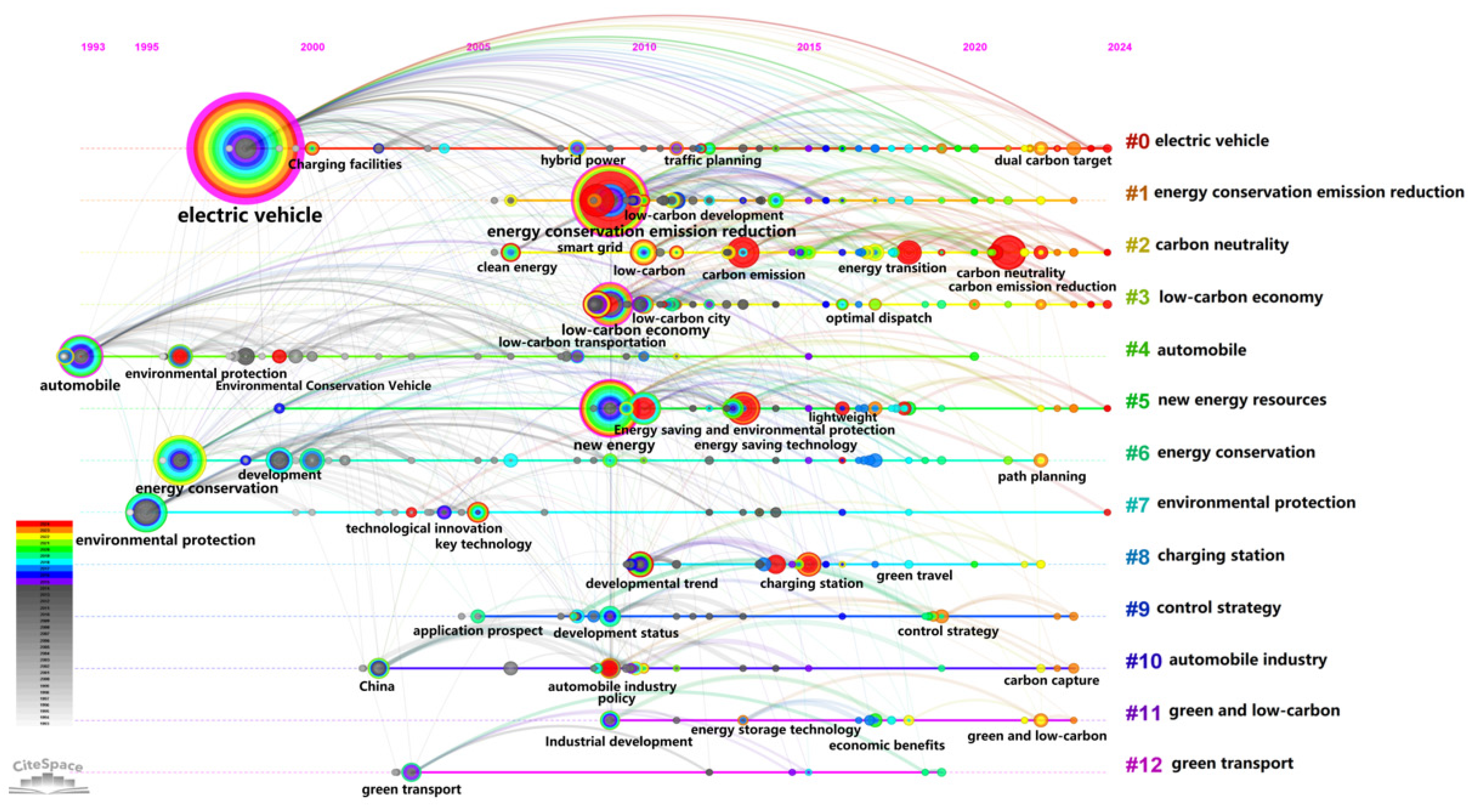
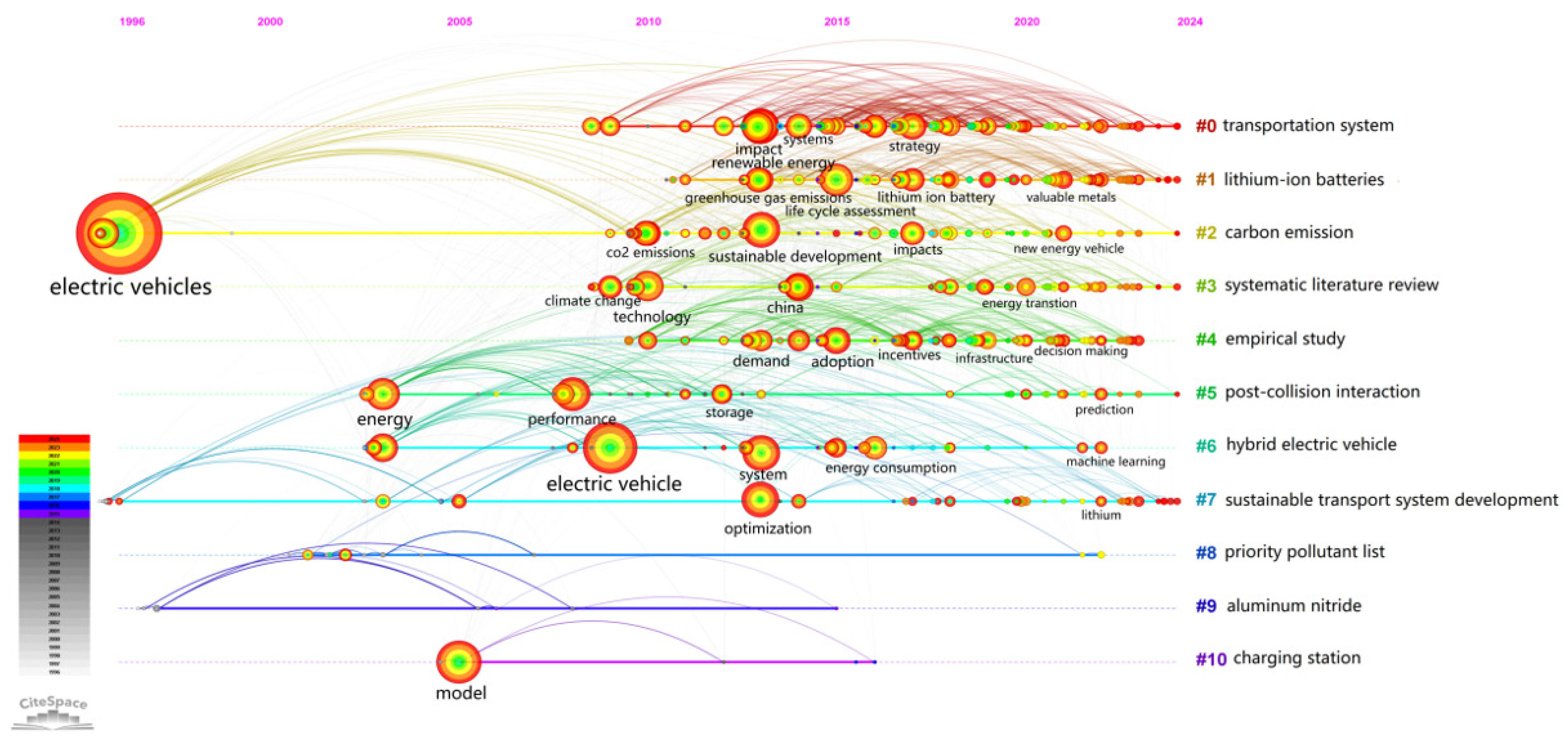
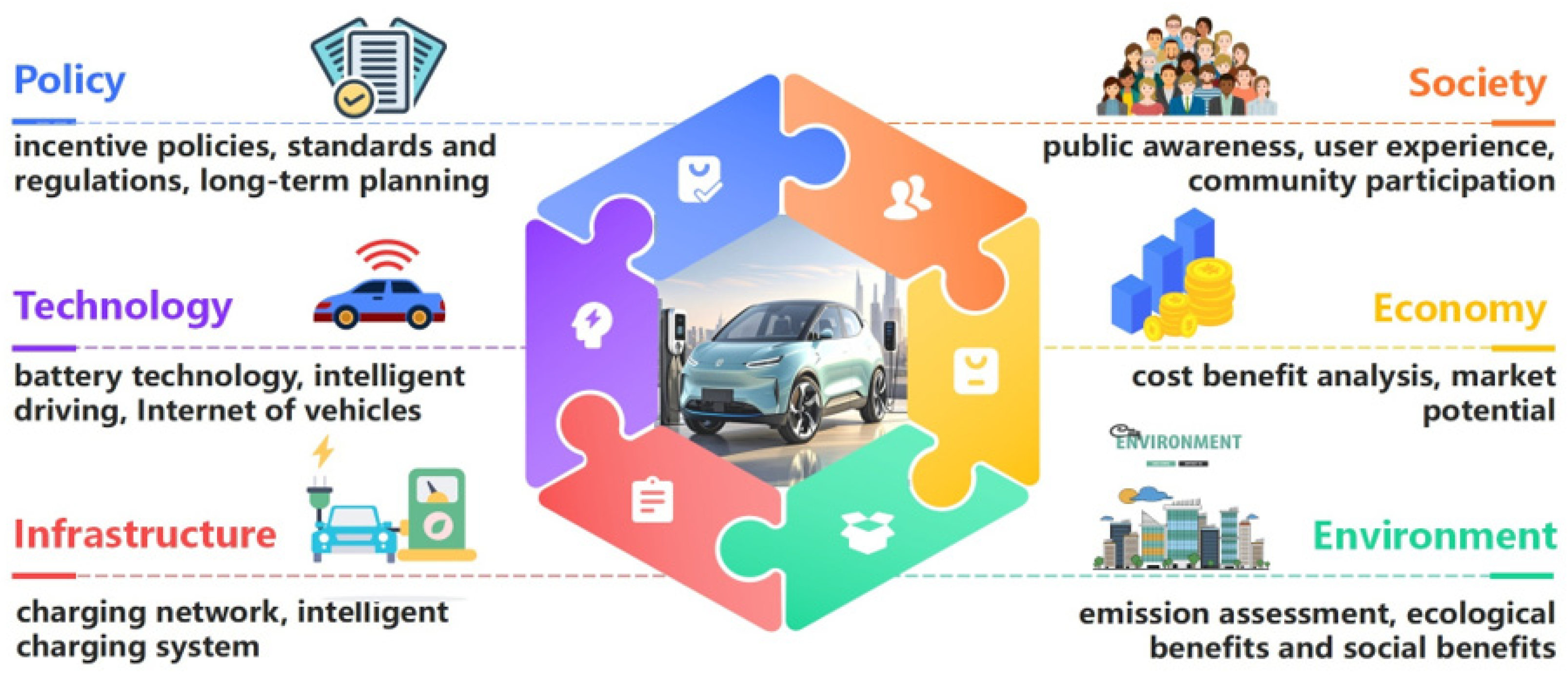
| No. | Citing Region | Cited Region | Z-Score |
|---|---|---|---|
| 1 | physics, materials, chemistry | chemistry, materials, physics | 6.058974 |
| 2 | physics, materials, chemistry | environmental, toxicology, nutrition | 2.334004 |
| 3 | veterinary, animal, science | chemistry, materials, physics | 2.0093758 |
| 4 | veterinary, animal, science | environmental, toxicology, nutrition | 2.493567 |
| 5 | veterinary, animal, science | economics, economic, political | 1.8910793 |
| 6 | mathematics, systems, mathematical | chemistry, materials, physics | 2.1854453 |
| 7 | mathematics, systems, mathematical | systems, computing, computer | 1.9405988 |
| 8 | mathematics, systems, mathematical | environmental, toxicology, nutrition | 3.233609 |
| 9 | mathematics, systems, mathematical | economics, economic, political | 2.4495487 |
| No. | Source | Citations | Total Link Strength |
|---|---|---|---|
| 1 | Applied Energy | 4202 | 187,096 |
| 2 | Journal of Cleaner Production | 4201 | 180,334 |
| 3 | Energy Policy | 3852 | 141,272 |
| 4 | Energy | 3475 | 165,398 |
| 5 | Renewable and Sustainable Energy Reviews | 3466 | 186,540 |
| 6 | Journal of Power Sources | 2660 | 160,651 |
| 7 | Transportation Research Part D: Transport and Environment | 2090 | 75,219 |
| 8 | Energies | 1932 | 88,780 |
| 9 | Sustainability | 1592 | 60,449 |
| 10 | International Journal of Hydrogen Energy | 1409 | 61,645 |
| 11 | Transportation Research Part A: Policy and Practice | 1325 | 49,658 |
| 12 | Energy Conversion and Management | 1275 | 78,757 |
| 13 | IEEE Transactions on Smart Grid | 1213 | 43,028 |
| 14 | Environmental Science & Technology | 1026 | 36,463 |
| 15 | Journal of Energy Storage | 1023 | 67,205 |
| No. | Countries | Count | Centrality | First Published Year | Times Cited (Average per Item) | H-Index | Citation Curve (Figure 9) |
|---|---|---|---|---|---|---|---|
| 1 | Peoples R China | 1100 | 0.03 | 1999 | 29.08 | 84 | Figure 9a |
| 2 | USA | 313 | 0.24 | 1999 | 41.45 | 60 | Figure 9b |
| 3 | UK | 250 | 0.25 | 1999 | 47.49 | 60 | Figure 9c |
| 4 | India | 170 | 0.07 | 1999 | 18.74 | 30 | Figure 9d |
| 5 | Canada | 103 | 0.34 | 1999 | 46.92 | 35 | Figure 9e |
| 6 | Germany | 98 | 0.43 | 2006 | 46.89 | 35 | Figure 9f |
| 7 | Italy | 89 | 0.13 | 1996 | 31.06 | 31 | Figure 9g |
| 8 | Australia | 85 | 0.18 | 2008 | 50.72 | 34 | Figure 9h |
| 9 | Spain | 66 | 0.22 | 2013 | 35.76 | 26 | Figure 9i |
| 10 | Saudi Arabia | 66 | 0.1 | 2014 | 25.93 | 18 | Figure 9j |
| 11 | Japan | 66 | 0.05 | 1996 | 33.28 | 26 | Figure 9k |
| 12 | South Korea | 63 | 0.04 | 1997 | 37.98 | 25 | Figure 9l |
| 13 | Denmark | 61 | 0 | 2011 | 55.26 | 30 | Figure 9m |
| 14 | France | 51 | 0.64 | 1996 | 31.47 | 22 | Figure 9n |
| 15 | Netherlands | 50 | 0 | 2008 | 41.44 | 27 | Figure 9o |
| No. | Count | Centrality | First Published Year | Authors |
|---|---|---|---|---|
| 1 | 21 | 0 | 2010 | Chen, L.Q. |
| 2 | 9 | 0 | 2004 | Wu, Q.T. |
| 3 | 9 | 0 | 1996 | Guo, T.J. |
| 4 | 9 | 0 | 2011 | Cao, X.A. |
| 5 | 8 | 0 | 2012 | Zhen, W.Y. |
| 6 | 6 | 0 | 2007 | Feng, F. |
| 7 | 5 | 0 | 2010 | Cheng, Z.B. |
| 8 | 5 | 0 | 2011 | Wang, P.X. |
| 9 | 5 | 0 | 2015 | Du, Y.S. |
| 10 | 4 | 0 | 2012 | Liu, Z.W. |
| No. | Count | Centrality | First Published Year | Authors |
|---|---|---|---|---|
| 1 | 23 | 0 | 2018 | Sovacool, Benjamin K. |
| 2 | 9 | 0 | 2021 | Wang, Yi |
| 3 | 9 | 0 | 2013 | Axsen, Jonn |
| 4 | 9 | 0 | 2020 | Strbac, Goran |
| 5 | 7 | 0 | 2020 | Li, Yang |
| 6 | 7 | 0 | 2018 | Noel, Lance |
| 7 | 6 | 0 | 2018 | Kester, Johannes |
| 8 | 6 | 0 | 2019 | Hook, Andrew |
| 9 | 6 | 0 | 2023 | Sinha, Chittaranjan |
| 10 | 6 | 0 | 2019 | Martiskainen, Mari |
| No. | Count | Centrality | First Published Year | Institution |
|---|---|---|---|---|
| 1 | 19 | 0 | 1999 | China Automotive Technology and Research Center, Tianjin, China |
| 2 | 15 | 0 | 2019 | China Automotive Technology and Research Center Co., Ltd., (CATARC), Tianjin, China |
| 3 | 10 | 0 | 2010 | Institute of Urban Economics of Tianjin Academy of Social Sciences, Tianjin, China |
| 4 | 8 | 0 | 2015 | Automotive Observer, Beijing, China |
| 5 | 8 | 0 | 2012 | School of Electrical Engineering of Southeast University, Nanjing, China |
| 6 | 8 | 0 | 2009 | China Electric Power Research Institute (CEPRI), Beijing, China |
| 7 | 8 | 0 | 2011 | Tongji University, Shanghai, China |
| 8 | 8 | 0 | 2011 | State Grid Energy Research Institute, Beijing, China |
| 9 | 8 | 0 | 2010 | China Association of Automobile Manufacturers, Beijing, China |
| 10 | 8 | 0 | 2014 | China Automotive Engineering Research Institute Co., Ltd., Chongqing, China |
| No. | Count | Centrality | First Published Year | Institution |
|---|---|---|---|---|
| 1 | 84 | 0.19 | 2010 | Tsinghua University |
| 2 | 48 | 0.09 | 2004 | Chinese Academy of Sciences |
| 3 | 47 | 0.13 | 2013 | Beijing Institute of Technology |
| 4 | 43 | 0.13 | 2003 | United States Department of Energy (DOE) |
| 5 | 38 | 0.06 | 2008 | Shanghai Jiao Tong University |
| 6 | 36 | 0.02 | 2016 | North China Electric Power University |
| 7 | 31 | 0.07 | 1999 | University of California System |
| 8 | 30 | 0.03 | 2011 | Imperial College London |
| 9 | 28 | 0.02 | 2013 | Southeast University—China |
| 10 | 28 | 0.07 | 2005 | University of Sussex |
| No. | Count | Centrality | First Published Year | Keyword |
|---|---|---|---|---|
| 1 | 138 | 0.18 | 2009 | energy conservation and emission reduction |
| 2 | 98 | 0.14 | 2009 | new energy |
| 3 | 87 | 0.09 | 1996 | energy conservation |
| 4 | 75 | 0.12 | 1993 | automobile |
| 5 | 67 | 0.14 | 2009 | low-carbon economy |
| 6 | 55 | 0.10 | 1995 | environmental protection |
| 7 | 38 | 0.04 | 2010 | low carbon |
| 8 | 33 | 0.03 | 2010 | energy conservation and environmental protection |
| 9 | 32 | 0.07 | 1999 | development |
| 10 | 32 | 0.05 | 2009 | smart power grids |
| 11 | 30 | 0.02 | 2021 | carbon neutrality |
| 12 | 28 | 0.02 | 2013 | energy saving technology |
| 13 | 25 | 0.04 | 2013 | carbon emission |
| 14 | 19 | 0.04 | 2010 | power battery |
| 15 | 18 | 0.03 | 2009 | automobile industry |
| 16 | 17 | 0.01 | 2009 | policy |
| 17 | 16 | 0.01 | 2009 | low carbon transportation |
| 18 | 15 | 0.01 | 2010 | developmental trend |
| No. | Count | Centrality | First Published Year | Keyword |
|---|---|---|---|---|
| 1 | 208 | 0.07 | 2005 | model |
| 2 | 179 | 0.23 | 2003 | energy |
| 3 | 161 | 0.05 | 2013 | impact |
| 4 | 160 | 0.03 | 2013 | system |
| 5 | 155 | 0.01 | 2013 | optimization |
| 6 | 153 | 0.03 | 2013 | renewable energy |
| 7 | 152 | 0.09 | 2008 | performance |
| 8 | 140 | 0.07 | 1996 | emissions |
| 9 | 139 | 0.02 | 2013 | sustainable development |
| 10 | 135 | 0.02 | 2015 | life cycle assessment |
| 11 | 130 | 0.02 | 2013 | management |
| 12 | 128 | 0.03 | 2010 | technology |
| 13 | 110 | 0.03 | 2014 | policy |
| 14 | 109 | 0.05 | 2014 | systems |
| 15 | 108 | 0.05 | 2003 | design |
| 16 | 104 | 0.02 | 2017 | strategy |
| 17 | 102 | 0.01 | 2013 | hybrid |
| 18 | 102 | 0.02 | 2014 | China |
| 19 | 102 | 0.03 | 2013 | demand |
Disclaimer/Publisher’s Note: The statements, opinions and data contained in all publications are solely those of the individual author(s) and contributor(s) and not of MDPI and/or the editor(s). MDPI and/or the editor(s) disclaim responsibility for any injury to people or property resulting from any ideas, methods, instructions or products referred to in the content. |
© 2025 by the authors. Licensee MDPI, Basel, Switzerland. This article is an open access article distributed under the terms and conditions of the Creative Commons Attribution (CC BY) license (https://creativecommons.org/licenses/by/4.0/).
Share and Cite
Li, D.; Lau, A.D.; Gong, Y. Electric Vehicles Empowering the Construction of Green Sustainable Transportation Networks in Chinese Cities: Dynamic Evolution, Frontier Trends, and Construction Pathways. Energies 2025, 18, 1943. https://doi.org/10.3390/en18081943
Li D, Lau AD, Gong Y. Electric Vehicles Empowering the Construction of Green Sustainable Transportation Networks in Chinese Cities: Dynamic Evolution, Frontier Trends, and Construction Pathways. Energies. 2025; 18(8):1943. https://doi.org/10.3390/en18081943
Chicago/Turabian StyleLi, Dacan, Albert D. Lau, and Yuanyuan Gong. 2025. "Electric Vehicles Empowering the Construction of Green Sustainable Transportation Networks in Chinese Cities: Dynamic Evolution, Frontier Trends, and Construction Pathways" Energies 18, no. 8: 1943. https://doi.org/10.3390/en18081943
APA StyleLi, D., Lau, A. D., & Gong, Y. (2025). Electric Vehicles Empowering the Construction of Green Sustainable Transportation Networks in Chinese Cities: Dynamic Evolution, Frontier Trends, and Construction Pathways. Energies, 18(8), 1943. https://doi.org/10.3390/en18081943






